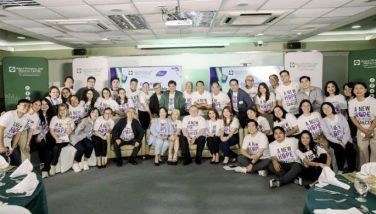Learning to cope with climate change
MANILA, Philippines - Constructing taller houses and choosing not to build near areas with bodies of water are just some of the adaptation measures that Filipinos can do to avoid casualties during typhoon calamities like Sendong.
This was one of the things discussed during a symposium entitled “Your Daily Dose of Earth Science” held recently at the University of the Philippines in Diliman, Quezon City.
The symposium was hosted by the Iuvenis Orbis Geological Fraternity (IOGF), a professional fraternity of Filipino geologists, in partnership with the University of the Philippines (UP) National Institute of Geological Sciences (NIGS), the national center of excellence for the advancement, dissemination and application of geology in the Philippines.
IOGF and UP-NIGS organized the symposium to showcase the relevance of geosciences in the daily life of ordinary people.
According to IOGF president Ronald Vicedo, “As an organization, we will always strive to help our government and our fellow Filipinos harness the power of the geological sciences for economic and social development, and environmental preservation.”
In his presentation entitled “Climate Change after Durban,” Environmental policy expert Dean Antonio G.M. La Viña of the Ateneo School of Government said that Filipinos should learn to survive weather conditions like heavy rainfalls that cause unprecedented flooding and even landslides as climate change will see worse weather disturbances in the future.
La Viña said that government, on the other hand, should come up with more advanced and effective rainfall monitoring systems, as well as build permanent evacuation centers, to avoid casualties during heavy typhoons.
He added that land use regulations should also be strictly implemented by local government, as human induced disasters include ill-planned infrastructures or housing projects that erode the country’s forests resulting to landslides.
As one of the Philippine government’s negotiators at the recently concluded climate change conference in Durban, South Africa, La Viña said that adaptation measures can augment the mitigation measures that countries across the globe are set to implement.
La Viña warned that the worst is yet to come, and climate change negotiations like the one in Durban forewarn of a 1.5 to 2 degree warmer world characterized by extreme weather conditions that are already beginning to happen.
La Viña cited as an example the heavy flooding in Australia and New Zealand, countries where typhoon-related disasters were not a traditional concern.
The expert stressed that the rich countries, most especially, should be able to commit to mitigation measures – primary of which is the reduction of emissions to avert a worst-case scenario of a global warming of five degrees.
La Viña also reported that, in terms of mitigation measures, the Durban conference produced the Durban Platform for Enhanced Action which would develop a new protocol, another legal instrument or outcome with legal force just like the Kyoto Protocol.
The new negotiating process will be launched next year and will culminate in 2015 with the aim of the new agreement taking effect in 2020.
“If countries would not have a strong and legally binding mitigation agreement by 2015, the worst impacts of climate change are likely inevitable,” said La Viña.
However, he said that the Philippines is still within the bounds of emission limits and has an adequate reforestation plan, but may need to focus more on adaptation measures for climate change.
For his part UP- NIGS professor and Undersecretary for Research and Development at the Department of Science and Technology (DOST) Dr. Graciano P. Yumul Jr. said that geoscientists play an increasing role in environmental management, land use planning and flood forecasting, among other climate and environment related activities.
Yumul enumerated the issues that geologists help address locally and internationally. These include the search, development and utilization of minerals and the accompanying socio-political and cultural issues that go with it; disaster risk management; the search for water; and preserving and enhancing the environmental integrity of our surroundings.
He added,” We have good graduates in the different fields of geosciences here in the Philippines. The academe, the government and industry just need to help these graduates meet international standards just so that they will be at par with graduates of other countries.”
Yumul pointed out that President Aquino’s “K plus 12” policy helps Filipino graduates in general to meet international standards which will be particularly helpful in a completely borderless Asia come 2015.
“Government, the academe and industry should also help graduates acquire needed additional competencies to ensure that the country’s future geologists will not only be competitive, but will also positively contribute to the country’s development,” he said.
Yumul added, “Stakeholders should always take stock of the different fields of geosciences to ensure relevance both in the local and global scene.”
- Latest

















